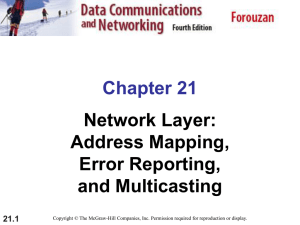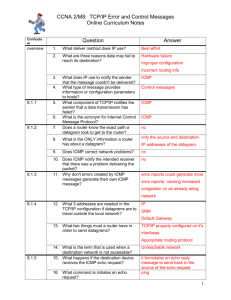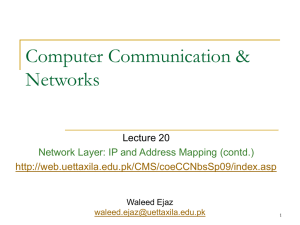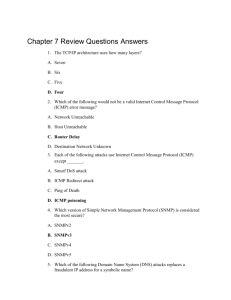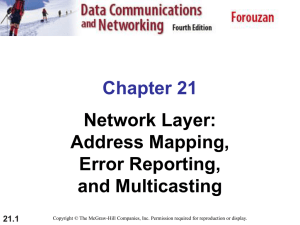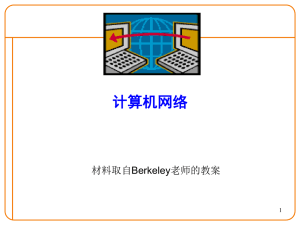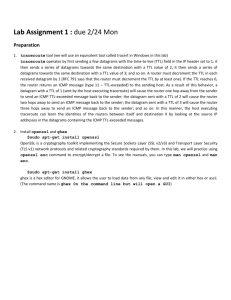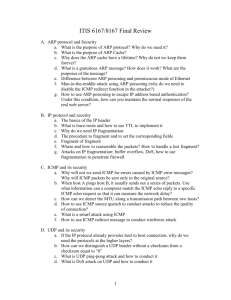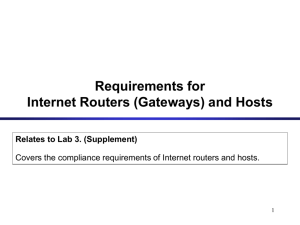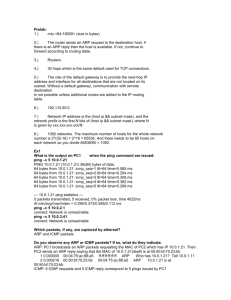Address Resolution Protocol
advertisement
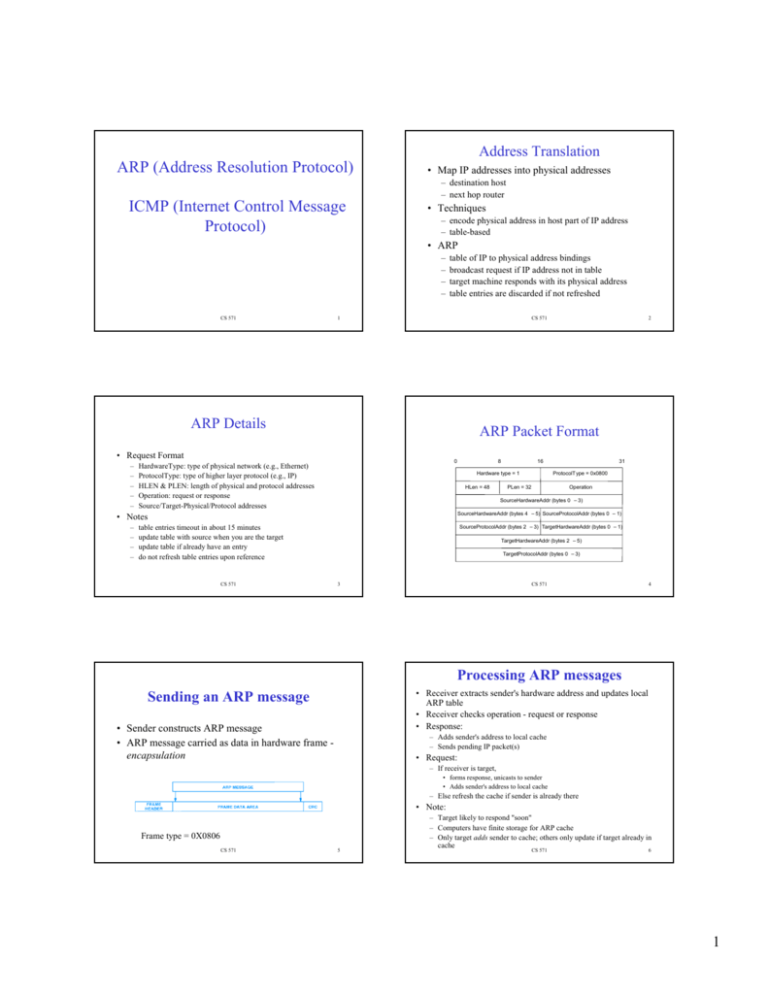
ARP (Address Resolution Protocol) ICMP (Internet Control Message Protocol) Address Translation • Map IP addresses into physical addresses – destination host – next hop router • Techniques – encode physical address in host part of IP address – table-based • ARP – – – – CS 571 table of IP to physical address bindings broadcast request if IP address not in table target machine responds with its physical address table entries are discarded if not refreshed 1 CS 571 ARP Details ARP Packet Format • Request Format – – – – – 2 0 HardwareType: type of physical network (e.g., Ethernet) ProtocolType: type of higher layer protocol (e.g., IP) HLEN & PLEN: length of physical and protocol addresses Operation: request or response Source/Target-Physical/Protocol addresses 8 16 Hardware type = 1 HLen = 48 31 ProtocolT ype = 0x0800 PLen = 32 Operation SourceHardwareAddr (bytes 0 – 3) • Notes SourceHardwareAddr (bytes 4 – 5) SourceProtocolAddr (bytes 0 – 1) – – – – SourceProtocolAddr (bytes 2 – 3) TargetHardwareAddr (bytes 0 – 1) table entries timeout in about 15 minutes update table with source when you are the target update table if already have an entry do not refresh table entries upon reference CS 571 TargetHardwareAddr (bytes 2 – 5) TargetProtocolAddr (bytes 0 – 3) 3 CS 571 4 Processing ARP messages • Receiver extracts sender's hardware address and updates local ARP table • Receiver checks operation - request or response • Response: Sending an ARP message • Sender constructs ARP message • ARP message carried as data in hardware frame encapsulation – Adds sender's address to local cache – Sends pending IP packet(s) • Request: – If receiver is target, • forms response, unicasts to sender • Adds sender's address to local cache – Else refresh the cache if sender is already there • Note: Frame type = 0X0806 CS 571 5 – Target likely to respond "soon" – Computers have finite storage for ARP cache – Only target adds sender to cache; others only update if target already in cache CS 571 6 1 Internet Control Message Protocol (ICMP) • Internet Control Message Protocol (ICMP) defines error and informational messages • Error messages: • Internet layer can detect a variety of errors: – – – – Checksum (header only!) TTL expires No route to destination network Can't deliver to destination host (e.g., no ARP reply) • Internet layer discards datagrams with problems • Some - e.g., checksum error - can't trigger error messages (hard to determine to whom to report the error) CS 571 7 ICMP message transport – – – – – Source quench (no buffer space) Time exceeded (TTL, or reassembly timer expires) Destination unreachable (network or host unreachable) Redirect Fragmentation required • Informational messages: – Echo request/reply – Address mask request/reply – Router discovery CS 571 8 ICMP and reachability • ICMP encapsulated in IP • An internet host, A, is reachable from another host, B, if datagrams can be delivered from A to B • ping program tests reachability - sends datagram from B to A that A echoes back to B • Uses ICMP echo request and echo reply messages • Internet layer includes code to reply to incoming ICMP echo request messages • ICMP messages sent in response to incoming datagrams with problems • ICMP message not sent for ICMP message CS 571 9 ICMP and internet routes CS 571 10 ICMP and path MTU discovery • List of all routers on path from A to B is called the route from A to B • traceroute uses UDP to non-existent port and TTL field to find route via expanding ring search • Sends ICMP echo messages with increasing TTL – Router that decrements TTL to 0 sends ICMP time exceeded message, with router's address as source address – First, with TTL 1, gets to first router, which discards and sends time exceeded message – Next, with TTL 1, gets through first router to second router – Continue until message from destination received • traceroute must accommodate varying network delays • Must also accommodate dynamically changing routes CS 571 Types of messages 11 • Fragmentation should be avoided • How can source configure outgoing datagrams to avoid fragmentation? • Source determines path MTU - smallest network MTU on path from source to destination • Source probes path using IP datagrams with don't fragment flag • Router responds with ICMP fragmentation required message • Source sends smaller probes until destination reached CS 571 12 2 ICMP and router discovery ICMP redirect • Router can fail, causing "black-hole" or isolating host from internet • ICMP router discovery used to find new router • Host can broadcast request for router announcements to auto-configure default route • Host can broadcast request if router fails • Router can broadcast advertisement of existence when first connected CS 571 • Default route may cause extra hop • Router that forwards datagram on same interface sends ICMP redirect • Host installs new route with correct router as next hop 13 CS 571 14 3

